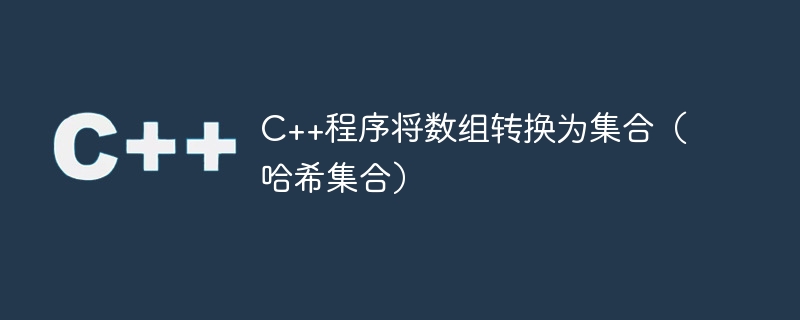C++程序将数组转换为集合(哈希集合)

数组是 C++ 中可用的数据结构,用于保存相同类型元素的顺序集合。数组的大小是固定的,但可以根据需要扩展或缩小。将数组视为相同类型变量的集合很重要,即使它用于存储数据集合。集合(或者在本例中为无序集合)是一种以任意顺序存储特定数据类型的元素的容器。哈希表用于实现 unordered_set,其中键被哈希到哈希表索引中,以帮助确保插入始终是随机的。
可以使用我们进一步讨论的各种方法来完成从数组到无序集的转换。
将数组元素一一插入到集合中
将数组转换为无序集的最简单方法是使用 for 循环并将每个数组元素单独插入到无序集中。接下来我们看一下语法和算法。
语法
int ip[] = <integer array>;
unordered_set<int> op;
for( int i : ip) {
op.insert(i);
}
算法
- 在整数数组 ip 中获取输入。
- 定义一个 unordered_set 操作。
- 对于数组 ip 中的每个元素 i,执行 -
- 将 IP 插入 op。
- 显示op的内容。
示例
#include <bits/stdc++.h>
using namespace std;
template <size_t N> unordered_set<int> solve( int (&ip)[N] )
{
//an unorderd set is declared
unordered_set<int> op;
//each element is inserted using insert function
for(int i : ip) {
op.insert(i);
}
return op;
}
int main()
{
int ip[] = {50, 80, 90, 40, 30};
unordered_set<int> op = solve(ip);
//display the input
cout<< "The input array is: ";
for(int i : ip) {
cout<< i << " ";
}
//display the output
cout<< "\nThe output set is: ";
for(int j : op) {
cout<< j << " ";
}
return 0;
}
输出
The input array is: 50 80 90 40 30 The output set is: 30 40 90 50 80
我们声明了一个整数数组 ip 并迭代数组中的所有元素。我们将输出集声明为 op,并使用容器中可用的插入函数将每个元素插入到无序集中。我们可以看到的结果是一组无序的值,这些值也存在于数组中。
使用范围构造函数构造集合
还可以使用其范围构造函数创建 unordered_set。范围构造函数有两个输入;输入数组的起始指针以及加上起始指针的输入数组的大小。
语法
int ip[] = ; int n = sizeof(ip) / sizeof(ip[0]); std::unordered_set op(ip, ip + n);
算法
- 在整数数组 ip 中获取输入。
- 使用 sizeof 运算符确定输入数组的大小。
- 将数组的大小分配给整数变量 n。
- 使用数组起始指针和数组大小构造一个 unordered_set 操作。
- 显示op的内容。
示例
#include <bits/stdc++.h>
using namespace std;
template <size_t N> unordered_set<int> solve(int (&ip)[N]) {
//the size is determined of the input array
int n = sizeof(ip) / sizeof(ip[0]);
//output set is constructed using range constructor
std::unordered_set<int> op(ip, ip + n);
return op;
}
int main()
{
int ip[] = {30, 20, 50, 10, 70};
unordered_set<int> op = solve(ip);
//display the input
cout<< "The input array is: ";
for(int i : ip) {
cout<< i << " ";
}
//display the output
cout<< "\nThe output set is: ";
for(int j : op) {
cout<< j << " ";
}
return 0;
}
输出
The input array is: 30 20 50 10 70 The output set is: 70 10 50 20 30
在此示例中,我们必须使用 sizeof 函数确定数组的大小。我们 将大小分配给变量 n 并使用指针 ip 和 ip + n 创建 unordered_set 操作。
结论
unordered_set 能够包含任何类型的数据。要更改它所保存的数据类型,我们必须更改 中包含的数据类型。该容器很好地支持原始类型和用户定义类型。实际上,unordered_set 工作得很好,通常提供恒定时间的搜索操作。 unordered_set 上的所有操作通常都需要恒定时间 O(1),尽管在最坏的情况下,它们可能需要长达线性时间 O(n),具体取决于内部哈希函数。
以上是C++程序将数组转换为集合(哈希集合)的详细内容。更多信息请关注PHP中文网其他相关文章!

热AI工具

Undresser.AI Undress
人工智能驱动的应用程序,用于创建逼真的裸体照片

AI Clothes Remover
用于从照片中去除衣服的在线人工智能工具。

Undress AI Tool
免费脱衣服图片

Clothoff.io
AI脱衣机

AI Hentai Generator
免费生成ai无尽的。

热门文章

热工具

记事本++7.3.1
好用且免费的代码编辑器

SublimeText3汉化版
中文版,非常好用

禅工作室 13.0.1
功能强大的PHP集成开发环境

Dreamweaver CS6
视觉化网页开发工具

SublimeText3 Mac版
神级代码编辑软件(SublimeText3)

热门话题
 如何使用 foreach 循环去除 PHP 数组中的重复元素?
Apr 27, 2024 am 11:33 AM
如何使用 foreach 循环去除 PHP 数组中的重复元素?
Apr 27, 2024 am 11:33 AM
使用foreach循环去除PHP数组中重复元素的方法如下:遍历数组,若元素已存在且当前位置不是第一个出现的位置,则删除它。举例而言,若数据库查询结果存在重复记录,可使用此方法去除,得到不含重复记录的结果。
 PHP数组深度复制的艺术:使用不同方法实现完美复制
May 01, 2024 pm 12:30 PM
PHP数组深度复制的艺术:使用不同方法实现完美复制
May 01, 2024 pm 12:30 PM
PHP中深度复制数组的方法包括:使用json_decode和json_encode进行JSON编码和解码。使用array_map和clone进行深度复制键和值的副本。使用serialize和unserialize进行序列化和反序列化。
 PHP 数组键值翻转:不同方法的性能对比分析
May 03, 2024 pm 09:03 PM
PHP 数组键值翻转:不同方法的性能对比分析
May 03, 2024 pm 09:03 PM
PHP数组键值翻转方法性能对比表明:array_flip()函数在大型数组(超过100万个元素)下比for循环性能更优,耗时更短。手动翻转键值的for循环方法耗时相对较长。
 深度复制PHP数组的最佳实践:探索高效的方法
Apr 30, 2024 pm 03:42 PM
深度复制PHP数组的最佳实践:探索高效的方法
Apr 30, 2024 pm 03:42 PM
在PHP中执行数组深度复制的最佳实践是:使用json_decode(json_encode($arr))将数组转换为JSON字符串,然后再将其转换回数组。使用unserialize(serialize($arr))将数组序列化为字符串,然后将其反序列化为新数组。使用RecursiveIteratorIterator迭代器对多维数组进行递归遍历。
 PHP数组多维排序实战:从简单到复杂场景
Apr 29, 2024 pm 09:12 PM
PHP数组多维排序实战:从简单到复杂场景
Apr 29, 2024 pm 09:12 PM
多维数组排序可分为单列排序和嵌套排序。单列排序可使用array_multisort()函数按列排序;嵌套排序需要递归函数遍历数组并排序。实战案例包括按产品名称排序和按销售量和价格复合排序。
 PHP 数组分组函数在数据整理中的应用
May 04, 2024 pm 01:03 PM
PHP 数组分组函数在数据整理中的应用
May 04, 2024 pm 01:03 PM
PHP的array_group_by函数可根据键或闭包函数对数组中的元素分组,返回一个关联数组,其中键是组名,值是属于该组的元素数组。
 PHP 数组合并去重算法:并行的解决方案
Apr 18, 2024 pm 02:30 PM
PHP 数组合并去重算法:并行的解决方案
Apr 18, 2024 pm 02:30 PM
PHP数组合并去重算法提供了并行的解决方案,将原始数组分成小块并行处理,主进程合并块的结果去重。算法步骤:分割原始数组为均等分配的小块。并行处理每个块去重。合并块结果并再次去重。
 PHP 数组分组函数在查找重复元素中的作用
May 05, 2024 am 09:21 AM
PHP 数组分组函数在查找重复元素中的作用
May 05, 2024 am 09:21 AM
PHP的array_group()函数可用于按指定键对数组进行分组,以查找重复元素。该函数通过以下步骤工作:使用key_callback指定分组键。可选地使用value_callback确定分组值。对分组元素进行计数并识别重复项。因此,array_group()函数对于查找和处理重复元素非常有用。






